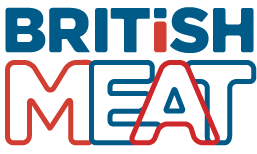British Meat Partner
National Sheep Association

Website: nationalsheep.org.uk
Overview
Sheep farming is more than just a business, it is part of our culture and heritage and farmers get huge pride and satisfaction from farming sheep. Farming and the environment are inextricably linked in the UK. Our unique landscape, formed through thousands of years of traditional farming methods and management by farmers, including the grazing of sheep, has encouraged the adaptation of many animal and plant species and resulted in the unique UK stratified sheep system we see today. While we have an increasing number of closed flocks that are mainly self sufficient in terms of replacements, the stratified system still exists and is divided into three tiers: hill, upland and lowland; playing host to approximately 90 different sheep pure breeds and crosses. The traditional stratified sheep industry, unique to Britain, is an economical, practical and environmentally sensible way of sheep farming, making the most of the different characteristics of breeds, UK climates and environments.
Environment & Sustainability
Around 70% of the UK agricultural land area is classified as grassland, the majority being permanent pasture with the remainder being part of a mixed farming system. Grazing livestock is the only viable option for this type of agricultural land as it is unsuitable for cropping. Sheep turn grass into food for our growing population, so without them, we’d lose ~60% of our food producing agricultural land (AHDB, 2020a).
Sheep farming throughout the UK has a critical role in the delivery of a new, sustainable land management policy that delivers for our landscapes, countryside and producers. Our sheep industry is predominantly grass fed and pastoral in nature. Policy changes that have come into effect since leaving the EU are removing current subsidies and focusing on payments for sustainable farming, local nature recovery and landscape recovery. Also known as ‘public goods’, things that farmers deliver of value to society, but that can’t be recouped from the normal marketplace.
Our sheep farmers are managing one of our most precious (and undervalued) resources, grassland, vitally important for our landscape, carbon capture, soil life, biodiversity, nature, and public mental and physical wellbeing. Most of Britain’s ecology has evolved alongside grassland and grazing animals. This is also the case for both grazed arable pastures and the short-term leys that play a hugely important role in rotational mixed farming and promotion of soil health – again something that is good for both food production and for nature.
Well managed grassland can be just as effective at storing soil carbon as woodland (Rothamstead), while also providing a multitude of other public goods such as creating wildlife habitats, enabling people to improve their mental and physical wellbeing, and avoiding wildfires with their huge environmental consequences. On top of this, sheep farming is at the core of many rural communities and economies, of which the public enjoy when they visit the countryside. When discussing environmentally friendly farming and greenhouse gas emissions, there is a serious misunderstanding of how they behave.
Until very recently the climate scientists assumed our three main warming gases, carbon dioxide, nitrous oxide and methane all behave identically. New metrics from Oxford University and research at Bangor have shown that whilst methane is associated with ruminants its life length is far shorter (around 12 years) compared to well over a hundred for N2O and CO₂, meaning concentrations cycle, rather than build up in the atmosphere. Sheep can even lock up carbon in their wool (around 50% of wool is carbon) as well physical benefits by providing a sustainable, naturally renewable, biodegradable product for clothing, home ware and even building insulation.
In summary, UK Sheep farming is in many ways already achieving many of the regenerative farming goals set out in the Government’s Agricultural Transition Plan.
Innovation
The UK sheep industry consists mainly of traditional enterprises and is not a sector that has huge infrastructure, making adoption of technologies difficult. However, inclusion of precision technology and novel R&D technologies combined with our traditional approaches allow our sector to be innovative.
Health and Disease monitoring
It has never been more crucial for people working with sheep to be enthusiastic, knowledgeable and aspiring to best practice. NSA encourages that by sharing everything we can on health, genetics and nutrition. We see increased communication and strong relationship between vets and farmers as vital for continuing to provide world leading health and welfare standards. NSA promotes ‘good vet-spend’ in terms of investment of evidence-based and timely preventative measures that boost flock performance and profitability, limiting fire-fighting treatments resulting in costs for both treatment and loss in production.
There have been some real advances in use of technologies within health screening in the sheep sector. For example, encouraging preventative screening for iceberg diseases (AHDB, 2019). With regards to gastrointestinal nematodes there has been an increased uptake in use of faecal egg counts before worming to ensure correct drug (if any) is selected. This ensures a shift move from any archaic thinking of worming every 2-3 weeks and ensuring treatments are only used when required, aiding resistance challenges. All these activities work towards combating the global battle of anthelmintic resistance (SCOPS, 2020).
The use of PCR testing for fluke and blood test screening for sheep scab antibodies, genotyping for parasite resistance and scanning for OPA are other examples of advanced technologies that are being utilised in the sheep sector. Inclusion of Maedi Visna (MV) and Johnes within Premium Sheep and Goat Health Schemes and the launch of the commercial MV screening programme have recently been rolled out, aiding sheep farmers further for improving national flock health status. Finally, the sheep sector is one of the lowest users of antibiotics and continue to work towards safeguarding against future antibiotic resistance (AHDB, 2019).
NSA is committed to educational campaigns to raise awareness of responsible antibiotic use and remains a key stakeholder in groups such as Responsible Use of Medicines in Agriculture (RUMA) Alliance. Our producers continue to work towards safeguarding against future antibiotic resistance (AHDB, 2019).
Performance recording and genetics
Selective breeding for improved characteristics is not a novel concept in the world of livestock breeding. However, new and improved technologies have allowed our sector to fully harness the power of performance recording and genetics. AHDB suggest that there is a large economic benefit for UK sheep farmers (£10.7 million annualised) from genetic improvement (Amer, et al.,2015). Performance recording alone captures valuable information regarding flock outputs allowing farmers to make informed decisions on future breeding and management strategies.
Selection in our commercial ewe flocks is driven by favourable maternal characteristics (milkiness, mothering ability, lamb survival, prolificacy), ensuring productivity gains. Terminal sire selection is more focused on meat quality, ensuring lamb production has a specific market outlet. Encouragement of data sharing and collaboration with meat processors should open opportunities for improvements of eating quality and even reduction in disease traits.
There is also the potential to maximise performance at grass through genetic selection in the flock. Use of advances in molecular genetics technology with DNA parentage testing allows information from an individual’s relatives and its own phenotypic records to be combined, providing the basis for prediction of genetic merit (Lewis & Simm, 2000).
Continued education through demonstration farms has been key for increasing adoption rates and there is growing interest in the potential for genomic technology to be used to enhance the genetic progress being made in UK sheep breeds.
Grazing technologies
Increased knowledge and understanding of the role of sustainable grazing practices for both animal health, welfare and pasture improvements have led to increased uptake within the sector. The benefits of incorporating grazing strategies such as rotational, mob and strip grazing allow farmers greater control over grass production which makes grass budgeting easier, improves grass quality year on year, allows higher animal performance per hectare and extends the grazing length (particularly around winter) as grass can be allocated better, reducing housing periods (AHDB, 2020b). Well-managed grassland (and therefore grazing) provides the most economic feed throughout the year, either as grazing or conserved forage and there is increasing evidence of the advantages of mixed farming for soil health and carbon sequestration. (AHDB, 2018).
With the addition of incorporating specific leys, clover and certain plant species such as chicory, plantain, birdsfoot trefoil, sainfoin and Lucerne, increased nutritional benefits and improvements to animal health and welfare (through parasite control) have also been observed. NSA work hard our members to encourage adoption for improved grassland management, promoting both the direct benefits to livestock health (and therefore productivity), but also for the extra environmental benefits gained.
Overall, greater adoption of innovation and sustainable farming practices will help our sector work towards achieving net zero emissions targets. The ambition of net zero is huge, but with investment, an improved toolkit for measuring carbon (and other GHGs) and increased education, we can continue to work towards a holistically sustainable future.
Food Security & standards
UK farmers already achieve some of the highest food safety and traceability standards as well as world leading animal health and welfare standards. We sincerely hope the British public will get behind the country’s farmers more than ever now in supporting their hard work producing the highest quality, good value farm produce whilst caring for their livestock and upholding high animal welfare standards. With our exit from the EU and as further trade deals are secured it will be more important than ever to support UK agriculture and buy British to be assured of food traceability and quality. One thing we must learn from the recent Covid-19 pandemic is that food security and resilient supply chains are equal in importance to environmental protection and climate change. This should be embraced by consumers, allowing them to make a closer connection and understanding between their food consumption and the environment.
Nutrition
Red meat is not only important for a balanced diet, but it also plays a key role in balanced, natural farming. It is naturally rich in protein and low in salt (sodium), providing us with multiple key vitamins and minerals including vitamin B12, iron, potassium and zinc. Plus, all nine essential amino acids, perfectly packaged for our body to absorb and make use of this nutrient dense food (AHDB, 2020a). Lamb and mutton that is pasture fed i.e. 100% grass fed, tends to be lower in total fat, have higher levels of ‘good fats’ including omega-3 fatty acids, a more balanced and heathier ratio of omega6:omega3 ratios fatty acids and higher levels of vitamins A and E. A recent review of meat consumption and cancer, heart disease, strokes or type 2 diabetes concluded there was no proven causal link to justify a reduction in meat consumption on health grounds (NSA, 2019).
There are a wide variety of products that can be sourced from sheep meat such as prime lamb, a firm favourite amongst consumers for Sunday roasts and special occasions; mince, burgers, diced lamb and lamb steaks are popular with our younger consumers; and even quality mutton is experiencing a resurgence of interest from foodies. Even the offal and low value cuts are popular in non-EU export markets.
In terms of British lamb once you look at nutrient density, the unprocessed nature of our product, land use, the ability to produce mainly from grass alone, the semi-natural, extensive method of sheep farming, the thousands of family farms, and the symbiotic relationship with nature both within and above the soil, then lamb starts to look like a highly sustainable food.
